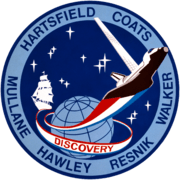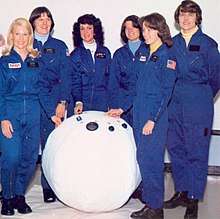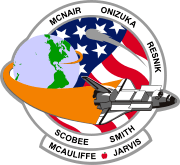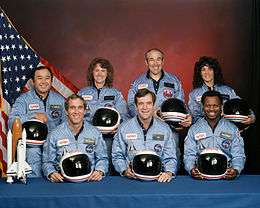Judith Resnik
| Judith Resnik | |
|---|---|
.jpg) | |
| NASA astronaut | |
| Nationality | American |
| Status | Killed during mission |
| Born |
April 5, 1949 Akron, Ohio |
| Died |
January 28, 1986 (aged 36) Cape Canaveral, Florida |
Other occupation | Engineer |
Time in space | 6d 00h 56m |
| Selection | 1978 NASA Group |
| Missions | STS-41-D, STS-51-L |
Mission insignia |
 |
| Awards |
|
Judith Arlene Resnik (/ˈrɛznɪk/; April 5, 1949 – January 28, 1986) was an American electrical engineer, software engineer, biomedical engineer and a NASA astronaut who died when the Space Shuttle Challenger was destroyed during the launch of mission STS-51-L.
Resnik was the second American female woman in space, logging 145 hours in orbit. She was also the first Jewish American in space, and the first Jewish woman of any nationality in space. She was a graduate of Carnegie Mellon University and had a Ph.D. magna cum laude in electrical engineering from the University of Maryland. The IEEE Judith Resnik Award for space engineering is named in her honor.
Early life
Resnik was born in 1949 to Sarah and Marvin, an optometrist, in Akron, Ohio. Both her parents were Jewish immigrants, both originally from the Ukraine (her father via Israel).[1] She was noticed for "intellectual brilliance" while still in kindergarten, and entered elementary school a year early.[2] At Firestone High School, she was an outstanding student, excelling in mathematics and classical piano,[3] and graduating as the valedictorian of her year. Playing classical piano with "more than technical mastery", she planned on becoming a professional concert pianist.[4] When questioned about her intensity at the piano, she replied "I never play anything softly".[5] Before college, she attained a perfect, 100% score in her SAT exam,[6] being the only girl in the country to do so that year, and one of the only 16 girls in the United States to have then achieved this feat at the time.[7]
She received a place at the Juilliard School to study classical piano, however she chose instead to study a B.S. in mathematics[8] at Carnegie Mellon University, where she was one of the few female students at Carnegie Tech.[9] In her second year at Carnegie Tech, she developed a passion for electrical engineering, discovering her interest in "practical aspects of science" after attending lectures with her boyfriend who was on the engineering course.[10] Her then boyfriend (and later husband) Michael Oldak, says: “She was a math whiz, but at some point math lost the numbers and she wanted something more tangible so she switched her collegiate major to electrical engineering”.[11] She received her B.S., majoring in electrical engineering, from Carnegie Mellon University in 1970, the year she married fellow student Michael Oldak.[12] They divorced in 1975. In 1977 she earned a Ph.D. in electrical engineering with magna cum laude honors at the University of Maryland. She was a member of Tau Beta Pi and Alpha Epsilon Phi.
Career
Upon graduation from Carnegie Mellon, Resnik was employed at RCA as a design engineer in missile and radar projects,[13] and winning the Graduate Study Program Award. She performed circuit design for the missile and surface radar division. For NASA, she worked on building custom integrated circuitry for the phased-array radar control systems, as well as NASA's sounding rocket and telemetry systems programs. An academic paper she wrote on special purpose integrated circuitry caught the attention of NASA during this time.[14]
Independently, in 1977, Resnik achieved her professional pilot's license, having achieved near perfect scores in her pilot's exams (two 100s and a 98).[15] Astronaut Jerome Apt described her as “an excellent pilot and a superb operator in space”.[16].
While working on her doctorate, Resnik also worked as a research fellow of biomedical engineering at the Laboratory of Neurophysiology at the National Institutes of Health. As a biomedical engineer, Resnik researched the physiology of visual systems.[17] An academic article she published in 1978, concerned the biomedical engineering of optometry ("A novel rapid scanning microspectrophotometer and its use in measuring rhodopsin photoproduct pathways and kinetics in frog retinas").[18] She additionally worked as a senior systems engineer for Xerox Corporation.[19]

Resnik was recruited at age 28 into the astronaut program (as one of six women selected out of 8000 applicants) in January 1978.[20] The program to find women astronauts had been developed by actress Nichelle Nichols, who volunteered her time in a special project with NASA to recruit minority and female personnel for the space agency.[21]
Resnik's first space flight was as a mission specialist on the maiden voyage of Discovery, from August to September 1984. She was likewise a mission specialist aboard Challenger for STS-51-L.[22][23][24] Henry Hartsfield described Resnik as the "astronaut's astronaut".[25]
While undergoing the intensive training of the NASA astronaut program, Resnik concurrently developed software and operating procedures for the Remote Manipulation System for NASA. In addition, she developed the deployment systems for the tethered satellite system,[26] as well as worked on orbiter development and she also created experiment software for NASA to use onboard its missions.[27]
Resnik was the second American woman in space, after Sally Ride, and fourth overall.[28] She was also the first American Jewish astronaut to go into space, the first Jewish woman, and at the time only the second Jew to go to space (after Boris Volynov of the Soviet Union).[29]
Her last recorded words onboard the Challenger were scanning for "LVLH" (low-vertical/low-horizontal), reminding all the crew of the cockpit of a switch configuration change.[30]
Following the Challenger disaster, examination of the recovered vehicle cockpit revealed that three of the crew members' Personal Egress Air Packs were activated: those of Resnik, mission specialist Ellison Onizuka, and pilot Michael J. Smith. The location of Smith's activation switch, on the back side of his seat, means that either Resnik or Onizuka could have activated it for him. This is the only evidence available from the disaster that shows Onizuka and Resnik were alive after the cockpit separated from the vehicle. If the cabin had lost pressure, the packs alone would not have sustained the crew during the two-minute descent.[31] She was the first dead body to be recovered from the crashed vehicle cockpit by Navy divers of the USS Preserver.
Legacy
Resnik has been awarded multiple posthumous honors, and has been honored with landmarks and buildings being named for her, including a lunar crater Resnik, located within the Apollo impact basin on the far side of the Moon. A dormitory at her alma mater, Carnegie Mellon, and the main engineering lecture hall at the University of Maryland are named for her. A memorial to her and the rest of the crew of Challenger has been dedicated in Seabrook, Texas, where she lived while stationed at the Johnson Space Center. In her hometown of Akron, Ohio, a school building was named in her honor: Judith Resnik Community Learning Center. There is also an elementary school in Gaithersburg, Maryland named in her honor: Judith A. Resnik Elementary School.
The IEEE Judith A. Resnik Award was established in 1986 by the Institute of Electrical and Electronics Engineers and is presented annually to an individual or team in recognition of outstanding contributions to space engineering in areas of relevance to the IEEE.[32]
The Society of Women Engineers (SWE) awards the Resnik Challenger Medal annually to a woman who has changed the space industry, has personally contributed innovative technology verified by flight experience, and will be recognized through future decades as having created milestones in the development of space as a resource for all humankind.[33]
The Challenger Center was established in 1986[34] by the families of the Challenger crew – including Judith's brother, Charles Resnik MD,[35][36] in honor of the crew members. The goal of the center is to increase STEM interest in children.
Resnik has been portrayed in works of nonfiction and fiction, including the 1990 made for TV movie Challenger where Julie Fulton portrayed her.
On February 23, 1990, Resnik was named one of ten finalists to represent Ohio in the National Statuary Hall in the U.S. Capitol in Washington, D.C.[37]
See also
References
![]()
- ↑ Judith Resnik (1949 - 1986) Jewish Virtual Library
- ↑ Women Spacefarers: Sixty Different Paths to Space By Umberto Cavallaro, Springer 2017, page 28
- ↑ Notable American Women: A Biographical Dictionary Completing the Twentieth Century, Volume 5, Susan Ware, Harvard University Press, 2004 page 426
- ↑ Women Spacefarers: Sixty Different Paths to Space By Umberto Cavallaro, Springer 2017, page 28
- ↑ [https://www.jewishvirtuallibrary.org/judith-resnik Judith Resnik (1949 - 1986)] Jewish Virtual Library
- ↑ Women in Space: 23 Stories of First Flights, Scientific Missions, and Gravity-Breaking Adventures, Karen Gibson (Chicago Review Press, 2014), page 91
- ↑ Judith Resnik (1949 - 1986) Jewish Virtual Library
- ↑ Women Spacefarers: Sixty Different Paths to Space By Umberto Cavallaro, Springer 2017, page 28
- ↑ Notable American Women: A Biographical Dictionary Completing the Twentieth Century, Volume 5, Susan Ware, Harvard University Press, 2004 page 426
- ↑ Women Spacefarers: Sixty Different Paths to Space By Umberto Cavallaro, Springer 2017, page 28
- ↑ Judy Resnik: Family, Friends Remember Engineer Who Reached for the Stars By Chriss Swaney, March 01, 2011, The Piper Carnegie Mellon University
- ↑ "Remembering the Challenger". The Ohio Historical Society Collections Blog. Archived from the original on 2016-01-05.
- ↑ UPI staff (4 February 1986). "Resnik was `living out a dream`". The Milwaukee Journal. UPI. Part 2 Page 5. Retrieved 3 July 2013.
Both got engineering jobs with RCA Corp. in Morristown N.J.
- ↑ Women Spacefarers: Sixty Different Paths to Space By Umberto Cavallaro, Springer 2017, page 29
- ↑ Women in Space: 23 Stories of First Flights, Scientific Missions, and Gravity-Breaking Adventures, Karen Gibson (Chicago Review Press, 2014), page 94
- ↑ Judy Resnik: Family, Friends Remember Engineer Who Reached for the Stars By Chriss Swaney, March 01, 2011, The Piper Carnegie Mellon University
- ↑ Women Spacefarers: Sixty Different Paths to Space By Umberto Cavallaro, Springer 2017, page 29
- ↑ Judith A. Resnik, Franco E. Malerba, Theodore R. Colburn, George C. Murray, and T. G. Smith, "A novel rapid scanning microspectrophotometer and its use in measuring rhodopsin photoproduct pathways and kinetics in frog retinas*," J. Opt. Soc. Am. 68, 937-948 (1978)
- ↑ Renner, Lisanne (29 January 1986). "Coverage from the day space shuttle Challenger exploded: Resnik liked a job label with no frills". Orlando Sentinel. Retrieved 3 July 2013.
Resnik didn't earn her pilot's license, the first step toward becoming an astronaut, until she left the National Institutes of Health in 1977 and took a job as a senior systems engineer with Xerox Corp. in El Segundo, Calif.
- ↑ Women in Space: 23 Stories of First Flights, Scientific Missions, and Gravity-Breaking Adventures, Karen Gibson (Chicago Review Press, 2014), page 94
- ↑ "Nichelle Nichols, NASA Recruiter". NASA. Archived from the original on 2009-12-22. Retrieved 2009-11-20.
- ↑ "Biographical Data - Judith A. Resnick". National Aeronautics and Space Administration. December 2003.
- ↑ "The 51-L Crew: Judy Resnick". The Challenger Center. Archived from the original on 2012-07-06.
- ↑ "Remarks of Senator John Glenn, Memorial Service For Judith Resnik". National Aeronautics and Space Administration. 1986-02-03.
- ↑ Women Spacefarers: Sixty Different Paths to Space By Umberto Cavallaro, Springer 2017, page 29
- ↑ Engineering Women: Re-visioning Women's Scientific Achievements and Impacts, By Jill S. Tietjen, Springer 2016, page 72
- ↑ Women Spacefarers: Sixty Different Paths to Space By Umberto Cavallaro, Springer 2017, page 29
- ↑ Wade, Mark. "Resnik". Archived from the original on 2009-10-08. Retrieved 2009-11-21.
- ↑ "Judith Resnik". Jewish Women's Archive. Retrieved 2009-11-20.
- ↑ Women Spacefarers: Sixty Different Paths to Space By Umberto Cavallaro, Springer 2017, page 31
- ↑ Joseph P. Kerwin. "Letter from Joseph Kerwin to Richard Truly relating to the deaths of the astronauts in the Challenger accident". National Aeronautics and Space Administration. Retrieved 2009-10-20.
- ↑ "IEEE Judith A. Resnik Award". IEEE. Retrieved 2009-12-27.
- ↑ "Resnik Challenger Medal". SWE. Retrieved 2017-03-24.
- ↑ "Who We Are". Challenger.org. Retrieved January 15, 2018.
- ↑ "Resnik, Charles - University of Maryland School of Medicine". MedSchool.UMaryland.edu. Retrieved January 15, 2018.
- ↑ "Charles Resnik". Challenger.org. Retrieved January 15, 2018.
- ↑ Jim Siegel (February 24, 2010). "10 Ohioans proposed to represent state in U.S. Capitol". The Columbus Dispatch. Archived from the original on February 26, 2010. Retrieved February 27, 2010.
External links
- Biography of Judith Resnik from IEEE
- January 1982 Pittsburgh Press article on Judith Resnik's planning her astronaut career
- Challenger's Enduring Mission by Charles Atkeison
- Autograph Letter of Astronaut Judy Resnik Shapell Manuscript Foundation
- Judith Resnik on IMDb
- Works by or about Judith Resnik in libraries (WorldCat catalog)
- "Judith Resnik reference site". Archived from the original on 2007-06-06. Retrieved 2007-10-07.
- Judith Resnik at Find a Grave
- Judith Resnik at Find a Grave
- Judith Resnik Autographed Letter


